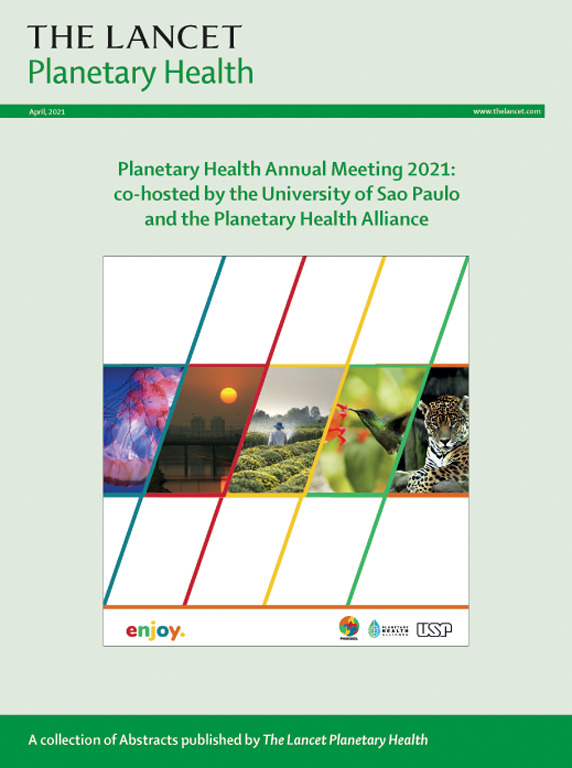在贝宁部署下一代双活性成分长效驱虫蚊帐对疟疾病媒产生杀虫剂抗药性的影响:为期三年的三臂群集随机对照试验的结果
IF 24.1
1区 医学
Q1 ENVIRONMENTAL SCIENCES
引用次数: 0
摘要
背景目前,全球有 84 个疟疾流行的国家和地区的疟疾病媒物种对杀虫剂产生抗药性。目前迫切需要新的病媒控制干预措施,包括使用具有不同作用模式的新活性成分的长效驱虫蚊帐,以延缓抗药性的演变和传播,缓解疟疾控制成果的逆转。我们的目的是在贝宁进行的一项分组随机对照试验中,评估两种双活性成分长效驱虫蚊帐对杀虫剂抗药性的纵向影响。方法这项为期 3 年的三臂分组随机对照试验于 2019 年 10 月 17 日至 2022 年 10 月 24 日期间在贝宁南部的三个地区进行,目的是比较含有氯虫苯甲酰胺或吡丙醚菊酯的长效驱虫蚊帐与仅含有拟除虫菊酯的长效驱虫蚊帐的效果。我们从 19 292 只蚊子(广义冈比亚按蚊)中收集了 36 个月的数据(基线为 3 个月,干预后为 3 年),采用生物测定法测量了纵向的杀虫剂抗药性表型特征,并在每个试验组的两个群组中采用定量、实时、反转录酶 PCR 检测代谢抗药性基因,测量了基因型抗药性特征。在所有三个试验组中,长效驱虫蚊帐对杀虫剂抗药性选择的影响都很明显,α-氯氰菊酯的中位致死剂量(LD50)从基线到长效驱虫蚊帐发放后 12 个月之间大约减少了一半(仅使用拟除虫菊酯的长效驱虫蚊帐第 21 组:LD50 78-78 μg/ml [95% CI 65-75-94-48] vs 35-93 [29-41-43.86],第 31 组:79-26 [65-40-96-44] vs 38-71 [30-88-48-53];氯虫苯甲酰胺-拟除虫菊酯 LLIN 第 43 组:104-30 [82-97-133-58] vs 43-99 [35-30-54-86];吡丙醚-拟除虫菊酯 LLIN 第 36 组:63-76 [52-1477] vs 43-93 [29-41-43]:63-76 [52-14-77-75] vs 37-96 [30-88-46-69] 和第 53 组:77-67 [57-63-104-56] vs 39-72 [29-26-53-97])。在随后的 2 年中,所有 3 个试验组的α-氯氰菊酯半数致死剂量都超过了基线值(第 3 年只使用除虫菊酯的长效驱虫蚊帐第 21 组:141-01 [111-70-181-90] ;第 31 组:115-15 [93-90-143-90] ):115-15[93-90-143-09];氯虫苯甲酰胺-拟除虫菊酯 LLIN 第 43 组:97-00 [77-24-123-54] 和第 55 组:126-99 [102-34-161-26];以及吡丙醚-拟除虫菊酯 LLIN 第 36 组:142-29 [112-32-184-84] 和第 53 组:109-88 [79-31-157-70])。我们观察到,在接触吡丙醚后,氯虫苯甲酰胺的易感性降低幅度极小,而生育率则有不同程度的显著降低,总体趋势是易感性在各试验年均呈上升趋势。有几个代谢基因与抗性选择有关,包括吡丙醚-拟除虫菊酯 LLIN 组中的 CYP6P4(该基因编码一种已知能在体外代谢吡丙醚的酶)和氯虫苯甲酰胺-拟除虫菊酯 LLIN 组中的 CYP6P3 和 CYP9K1(这两种基因编码的酶都参与杀虫剂的活化)。释义在使用氯虫苯甲酰胺-拟除虫菊酯长效驱虫蚊帐 24 个月后,它不再能减轻贝宁南部这一地区的拟除虫菊酯抗药性选择。这一发现为目前的蚊帐采购计划提出了问题,因为目前的采购计划是以 3 年的蚊帐使用寿命为基础的。了解下一代长效驱虫蚊帐对杀虫剂抗药性选择的影响,对于务实地设计前瞻性抗药性管理策略至关重要。本文章由计算机程序翻译,如有差异,请以英文原文为准。
The effect of next-generation, dual-active-ingredient, long-lasting insecticidal net deployment on insecticide resistance in malaria vectors in Benin: results of a 3-year, three-arm, cluster-randomised, controlled trial
Background
Insecticide resistance among malaria vector species now occurs in 84 malaria-endemic countries and territories worldwide. Novel vector-control interventions, including long-lasting insecticidal nets (LLINs) that incorporate new active ingredients with distinct modes of action, are urgently needed to delay the evolution and spread of resistance and to alleviate reversals in malaria-control gains. We aimed to assess the longitudinal effect of two dual-active-ingredient LLINs on insecticide resistance during a cluster-randomised, controlled trial in Benin.
Methods
This 3-year, three-arm, cluster-randomised, controlled trial was conducted between Oct 17, 2019, and Oct 24, 2022, in three districts in southern Benin, to compare the effects of LLINs containing chlorfenapyr–pyrethroid or pyriproxyfen–pyrethroid with LLINs containing pyrethroid only. In 19 292 mosquitoes (Anopheles gambiae sensu lato) collected over 36 months—3 months of baseline followed by 3 years post-intervention—we measured longitudinal phenotypic insecticide resistance profiles using bioassays and genotypic resistance profiles using quantitative, real-time, reverse transcriptase PCR of metabolic resistance genes in two clusters per trial group. The trial was registered with ClinicalTrials.gov, NCT03931473.
Findings
In all three trial groups, a significant effect of LLINs on insecticide resistance selection was evident, with the median lethal dose (LD50) of α-cypermethrin approximately halving between baseline and 12 months post-LLIN distribution (pyrethroid-only LLIN cluster 21: LD50 78·78 μg/ml [95% CI 65·75–94·48] vs 35·93 [29·41–43.86] and cluster 31: 79·26 [65·40–96·44] vs 38·71 [30·88–48·53]; chlorfenapyr–pyrethroid LLIN cluster 43: 104·30 [82·97–133·58] vs 43·99 [35·30–54·86]; and pyriproxyfen–pyrethroid LLIN cluster 36: 63·76 [52·14–77·75] vs 37·96 [30·88–46·69] and cluster 53: 77·67 [57·63–104·56] vs 39·72 [29·26–53·97]). Over the subsequent 2 years, the LD50 of α-cypermethrin increased past baseline values in all three trial groups (year 3 pyrethroid-only LLIN cluster 21: 141·01 [111·70–181·90] and cluster 31: 115·15 [93·90–143·09]; chlorfenapyr–pyrethroid LLIN cluster 43: 97·00 [77·24–123·54] and cluster 55: 126·99 [102·34–161·26]; and pyriproxyfen–pyrethroid LLIN cluster 36: 142·29 [112·32–184·84] and cluster 53: 109·88 [79·31–157·70]). We observed minimal reductions in chlorfenapyr susceptibility and variable but significant reductions in fertility after pyriproxyfen exposure, with an overall trend of increasing susceptibility across trial years. Several metabolic genes were implicated in resistance selection, including CYP6P4 in the pyriproxyfen–pyrethroid LLIN group, which encodes an enzyme known to metabolise pyriproxyfen in vitro, and CYP6P3 and CYP9K1 in the chlorfenapyr–pyrethroid LLIN group, both of which encode enzymes that are involved in pro-insecticide activation.
Interpretation
After 24 months of use, chlorfenapyr–pyrethroid LLINs no longer mitigated pyrethroid resistance selection in this area of southern Benin, which has high malaria transmission dominated by highly resistant A gambiae sensu lato. This finding raises issues for current net-procurement schedules, which are based on an operational net lifespan of 3 years. Knowledge of the effects of next-generation LLINs on insecticide-resistance selection is crucial for the pragmatic design of prospective resistance-management strategies.
Funding
UNITAID and The Global Fund to Fight AIDS, Tuberculosis and Malaria.
求助全文
通过发布文献求助,成功后即可免费获取论文全文。
去求助
来源期刊

Lancet Planetary Health
Multiple-
CiteScore
28.40
自引率
2.30%
发文量
272
审稿时长
8 weeks
期刊介绍:
The Lancet Planetary Health is a gold Open Access journal dedicated to investigating and addressing the multifaceted determinants of healthy human civilizations and their impact on natural systems. Positioned as a key player in sustainable development, the journal covers a broad, interdisciplinary scope, encompassing areas such as poverty, nutrition, gender equity, water and sanitation, energy, economic growth, industrialization, inequality, urbanization, human consumption and production, climate change, ocean health, land use, peace, and justice.
With a commitment to publishing high-quality research, comment, and correspondence, it aims to be the leading journal for sustainable development in the face of unprecedented dangers and threats.
 求助内容:
求助内容: 应助结果提醒方式:
应助结果提醒方式:


